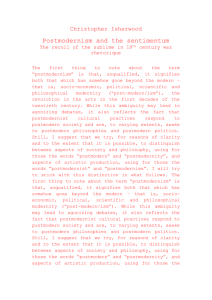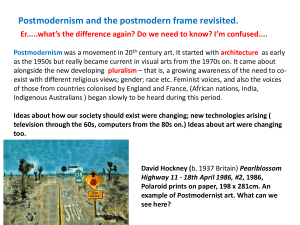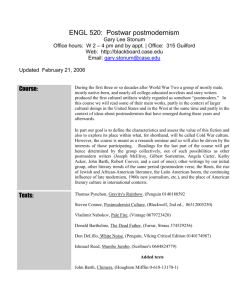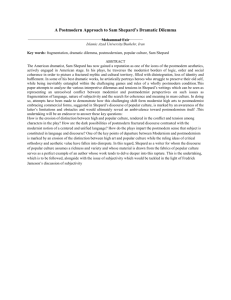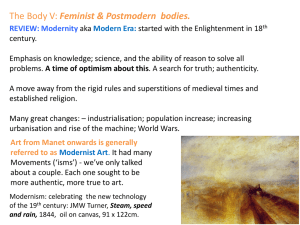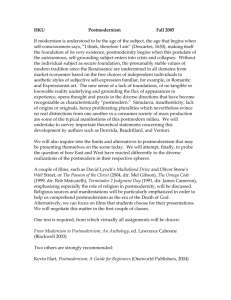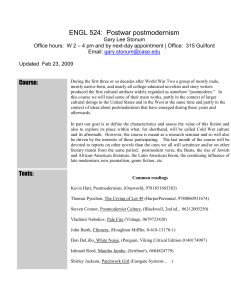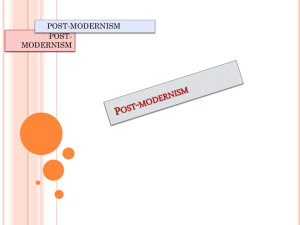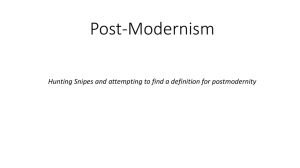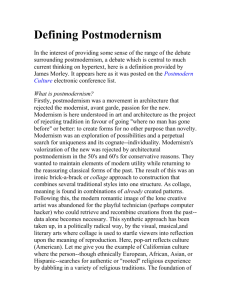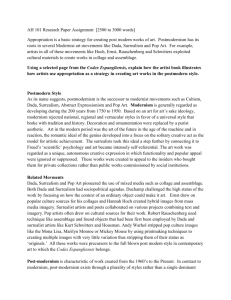Postmodernism and the postmodern frame revisited
advertisement
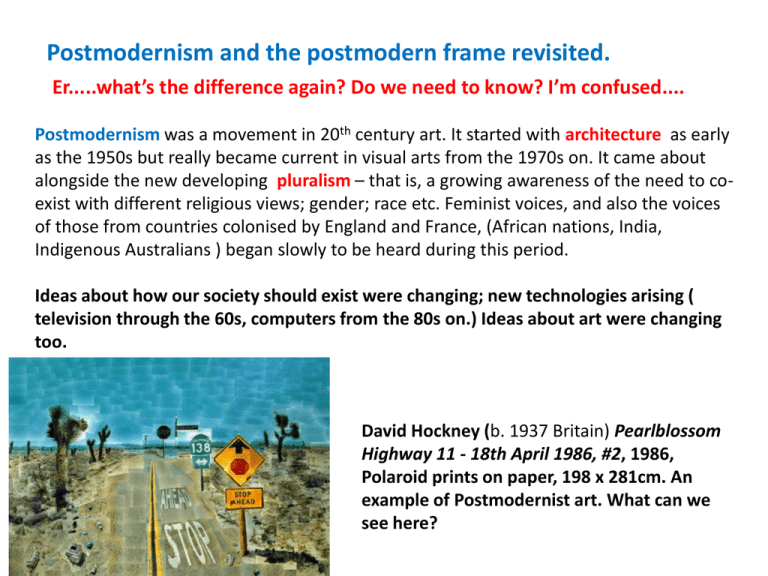
Postmodernism and the postmodern frame revisited. Er.....what’s the difference again? Do we need to know? I’m confused.... Postmodernism was a movement in 20th century art. It started with architecture as early as the 1950s but really became current in visual arts from the 1970s on. It came about alongside the new developing pluralism – that is, a growing awareness of the need to coexist with different religious views; gender; race etc. Feminist voices, and also the voices of those from countries colonised by England and France, (African nations, India, Indigenous Australians ) began slowly to be heard during this period. Ideas about how our society should exist were changing; new technologies arising ( television through the 60s, computers from the 80s on.) Ideas about art were changing too. David Hockney (b. 1937 Britain) Pearlblossom Highway 11 - 18th April 1986, #2, 1986, Polaroid prints on paper, 198 x 281cm. An example of Postmodernist art. What can we see here? Modernism in Architecture. For much of the 20th century, architecture was dominated by forms which used concrete, glass and steel in primarily simple, streamlined and functional ways. The ornament that was part of earlier architectural styles was dropped. There was an interest in being ‘true to materials’- not trying to hide the fact of the modern materials that were being used – and a no-nonsense honesty that arose from the horrors of two World Wars. In Europe especially after WW2, there was a need to house a growing population after many old parts of major cities had been ruined. There was a new start, destruction of slums and a hope that decent, low-cost housing would improve the lives and health of many communities. This hope for abetter world, made possible by new technologies, developed into the International Style. We may recall it was initially associated with the architects from the Bauhaus design school - Mies Van de Rohe and Walter Gropius - and also LeCorbusier. Modernist architecture had a strong sense of Rationalism. Let’s be grownup. Let’s get real. The sense of being authentic, a thread running throughout Modernism, was strong. Le Corbusier & others, UN Building, New York 1952 Walter Gropius, German (18831969)Bauhaus workshop buildings c. 1925 –An example of International Style. Now read on! Postmodernist ideas in Architecture If Modernist architecture was all about simplicity, streamlining, avoidance of embellishment or looking back to previous styles, Postmodernism in Architecture said ‘ah....nup.’ There was a interest in historicism – looking back to, and appropriating aspects of previous styles – but without a sense of reverence. More a sense of picking and choosing according to whim, with no sense of the hierarchy that often characterised previous ages. Postmodern architecture had an element of a sense of play from all this picking and choosing (eclecticism). Ornament and surface were considered important again, and also a movement away from strictly orthogonal lines. Guggenheim Museum, Bilbao Spain,1997, designed by Frank Gehry. New State Gallery of Stuttgart, Berlin, 1983, is a famously Postmodern building. Postmodernism as a visual art movement came a little later, in 1970s/80s. Like Postmodernism in Architecture, it tended to look back to various styles and ideas (rather than the typically Modernist notion of always looking forward to find better, more authentic and more original ways of expressing truth.) Review: Some key characteristics 1. Scepticism about modernity, rather than a faith and optimism about it. ‘Widespread realisation of the gap between the optimistic ideas of modernity and the reality of acid rain, AIDS, nuclear pollution and urban decay.’ ( HSC Online.) Modernity was never wholeheartedly accepted at all times of course. (consider the response to WW1 by the Dadaists. The Surrealists, also reacted against society of its time, with the repression and regulation of modern life.) Scepticism, like so many postmodern forms, is now a firmly established part of contemporary art practice. Barbara Kruger (US, b.1945), Untitled (you invest in the divinity of the masterpiece), photocopy, 1982, 182 X 115cm 2. Mixing of high and low culture. Postmodernist imagery such as Kruger’s challenged the idea of any hierarchy in art materials and genres, and would knowingly mix imagery to challenge us as an audience, and make us think. Use of iconic imagery helps us become more aware of the meaning that such imagery can hold for us. How does Kruger’s use of an overlay of text act? Whose voice is it? You construct intricate rituals which allow you to touch the skin of other men, 1981. Gay rights were an issue that came to prominence in this period as well. Barbara Kruger, Questions, 1991, photographic screenprint, 167 x 236cm Mid 20th century was a time when Feminist issues became more relevant and mainstream. Women protested their lack of representation in art institutions. Another challenge was to the side-lining of traditional women’s crafts –knitting, sewing, textile work of all kinds. These kinds of art forms are a part of contemporary practice now, but this was new ground in the 1970s. Feminist art could be seen as a sub-set of Postmodernist art. Like other postmodernist ideas, though it is has become part of contemporary practice. Guerrilla Girls Poster, mid 1980s. They were posted on the streets of New York and referred to as ‘Public Service Announcements’. Note appropriation of art from the Canon. Ingres, Grand Odalisque, 1814. 3. Challenging of all types of structures; traditions and beliefs. We saw the challenging of previous traditions with the avantgarde in Modernism. The new movement always thought it had the better way to get to an authentic expression. With Postmodernism, there is not that sense of ‘we have the answer’. It is more a case of ‘there ARE no definite answers. No one path is correct.’ There is no one, single truth. Rather, there are many stories; many voices; multiple points of view. Bruce Nauman, (b. 1941, U.S. ) The true artist helps the world by revealing mystic truths, fluorescent tubes, MDF backing board 165 x 165cm, 1967. An early example of a Postmodern piece, incorporating nontraditional materials (neon sign), text and a tongue in cheek comment about the role of the artist... Like Kruger 20 years later, he’s chosen the ‘low art’ advertising style to convey a powerful message. 4. Appropriation & questioning the notion of originality. This is such an established part of contemporary practice that it’s easy to forget that there was a time when appropriation was much more subtle and understated…or at least, it didn’t have a political message attached to it. It was seen as looking back to the traditional Masters… a mark of respect and proper process. The idea of appropriating to questioning ideas of the authentic and the original started with Duchamp, but it took off as a serious artform with Postmodern art. Our friend Imants Tillers is the prime example. What are the ideas behind his appropriating? Tillers, Inherited absolute, 1992, oil and oil stick on canvas boards, 231 x 228cm. Art could never be the same after Duchamp questioned what an art object actually was. Likewise, the use of illusion and way the surface of a work was considered was forever changed after Manet. Equally, art practice was altered by the movement of Postmodernism. Contemporary art practice, whilst not technically regarded as part of Postmodernism as a movement, is by its nature postmodern. Things can never be the same. Sometimes you can’t turn back the clock. Issues of Feminism; voices of previously marginalised people (Indigenous, gay, poor) and the changing face of society’s structures all effect what kind of art is produced. Michael Zavros, The New Round Room, 2012, 210 x 167cm. This contemporary piece describes a room in the Versailles Palace (where King Louis IV lived in the 18th century) but uses postmodern practices by juxtaposing a modern bench-press into this interior. (Zavros was imagining what a wealthy young man might have in this room if he had lived now.) This adds a light-hearted note and helps us consider things from a different viewpoint– a key characteristic of postmodernism. Okay….so what about our postmodern frame then? Think for a moment about the whole idea of using the Frames to consider art – Cultural, Subjective, Structural, Postmodern. What do they do? They serve to emphasise the the fact that all these aspects are relevant to understanding art. We need to recognise that the time and place the artist is working in will effect the artwork and how meaning is conveyed. We need to acknowledge the feelings behind an artwork, or how we may respond. We need to analyse compositional strategies and see how certain images and signs will convey certain meanings and act as codes that are relevant to the culture. We see the relevance of previous art movement and how they may have influenced the art. Our Conceptual Framework emphasises the importance of the relationships that surround the making of art. The world of the artist; their relationship to the audience (and who that audience may comprise); their relationship to the art, etc. The actual fact that we use the tools of Frames and Conceptual Framework is a direct consequence of Postmodernist thought. It recognises there are many voices; many considerations; and that things are not necessarily as they seem. The various Frames and Conceptual Framework overlap all the time. There is nothing amazing about the postmodern one, in and of itself. It is easier to apply the postmodern frame too more contemporary work, as this work will tend to have characteristics of Postmodernism about it. However the idea of recognising challenges to structures in particular is something we’ve been able to do all along. Resources HSC ONLINE: http://www.hsc.csu.edu.au/visual_arts/content/practice/art_practice_postmodern_frame/MDoc10Con temporaryArt.html About.com Architecture: http://architecture.about.com/od/greatbuildings/ig/Modern-and-PostmodernHouses/Vanna-Venturi-House.htm
